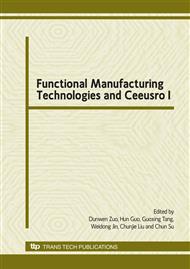p.1
p.5
p.9
p.13
p.17
p.21
p.26
p.30
Effective Dumbbell-Tool in Nanotechnology System from Optical Device of Computer Display
Abstract:
The low yield rate of the transparent conducting oxide (TCO) is easily existent through the processes of semiconductor production. A nanotechnology system of the recycling process for removing the TCO-layer from displays’ color filter surface of computer display is presented. By establishing a recycling process for the ultra-precise removal of the thin film nanostructure, the semiconductor optoelectronic industry can effectively reclaim defective products, reducing both production costs and pollution for the technical application. In the current experiment, the major interest is the design mechanism features of the removal process for a thin layer of TCO and an effective design dumbbell-tool. For the recycling processes, a small diameter of the positive-electrode, a small gap-width between the negative-electrode and the positive-electrode corresponds to a higher removal rate for the TCO-layer. A high rotational speed of the dumbbell-tool, or a high flow velocity of the electrolyte increases the dreg discharge mobility and improves the removal effect. A higher working temperature or a higher concentration of the electrolyte corresponds to a higher removal rate for the TCO-layer. An enough electric power corresponds with a higher feed rate of the displays’ color filter produces a fast removal rate and reduces the production costs. An effective design of the system mechanism and the machining tool in the electroremoval processes requires quite a short time to make the TCO-layer remove easily and cleanly.
Info:
Periodical:
Pages:
9-12
Citation:
Online since:
January 2010
Authors:
Keywords:
Price:
Сopyright:
© 2010 Trans Tech Publications Ltd. All Rights Reserved
Share:
Citation:


